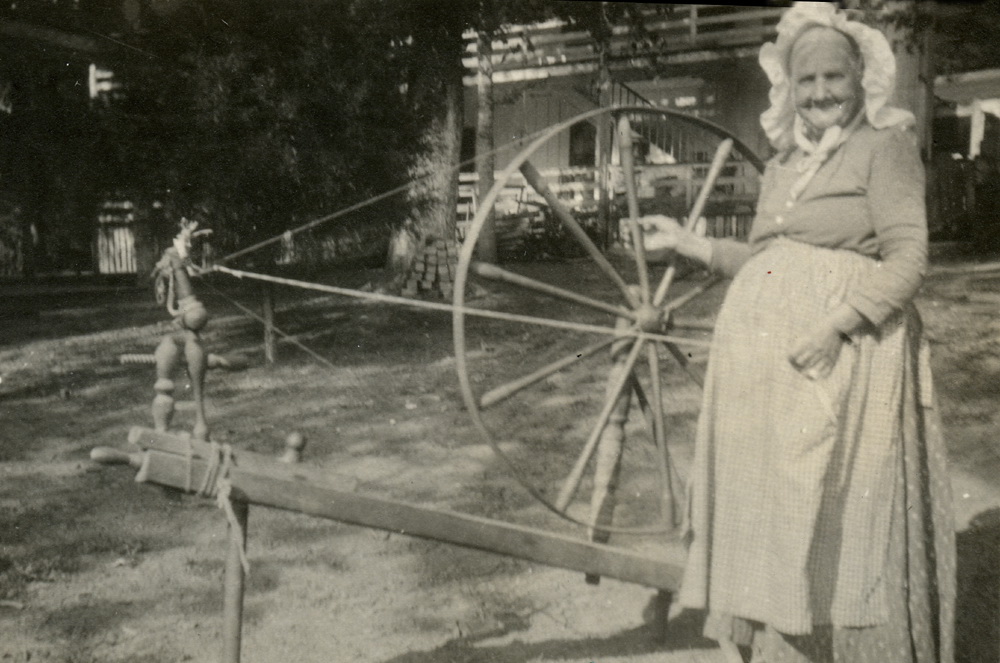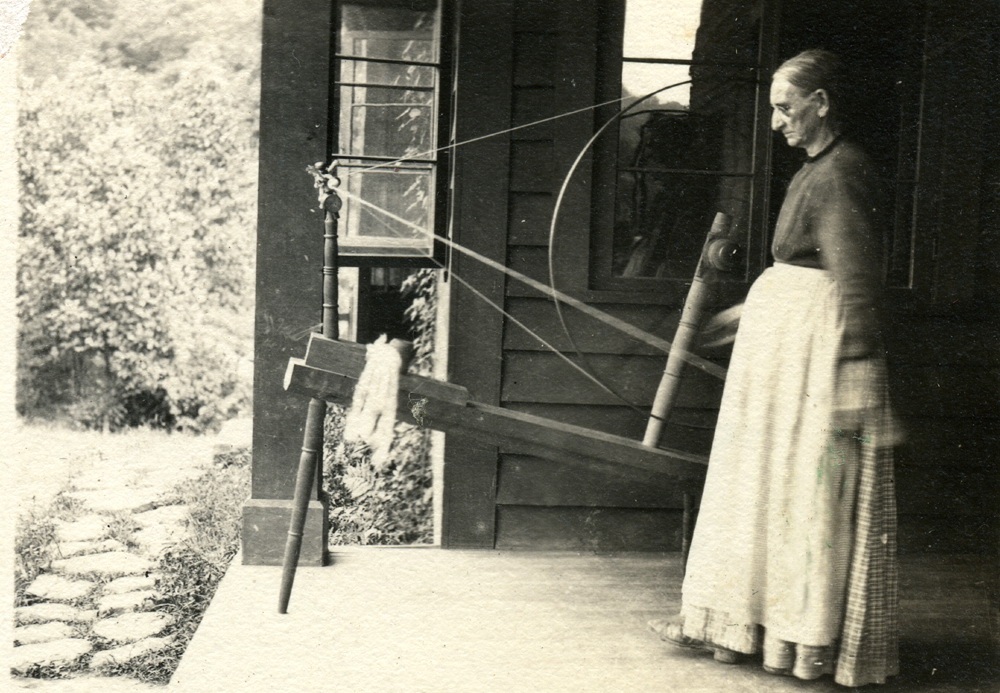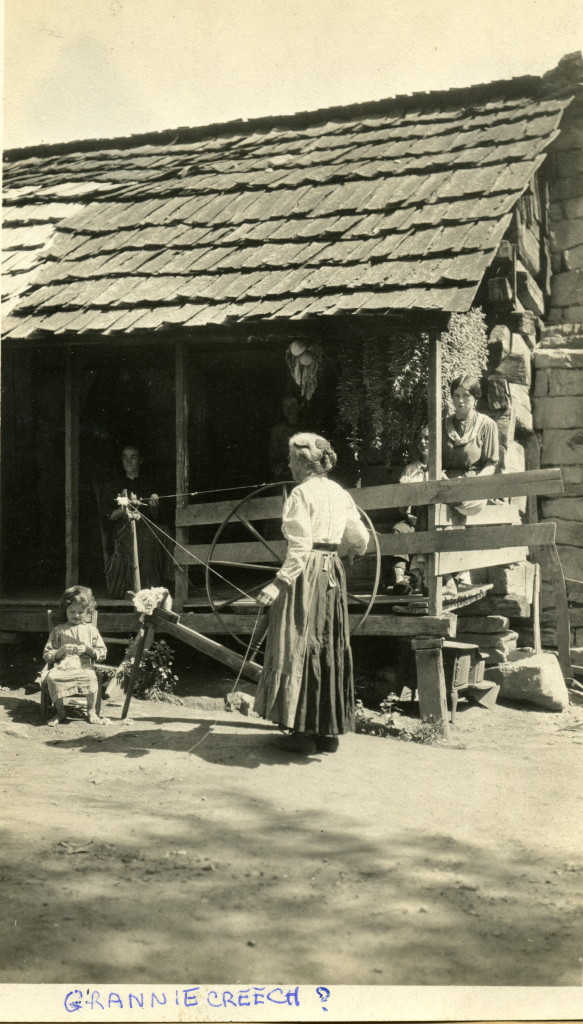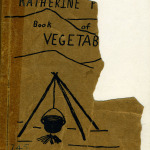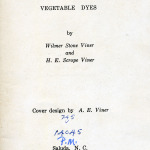WEAVING AT PMSS – BEGINNINGS
One might say that Pine Mountain was conceived among coverlets. Weaving at Pine Mountain Settlement School certainly was encouraged by the re-discovery of the craft of coverlet weaving and the enthusiastic collecting of mountain weaving near the turn of the last century. Katherine Pettit, founder of Pine Mountain Settlement School and earlier of Hindman Settlement School, was an avid collector of “kivers.” Her interest in the exquisite craft of coverlet weaving kept her roaming the mountains in the early years of the twentieth century in search of new patterns and techniques. It was the search for beautiful mountain “kivers” that kept Pettit journeying across the Eastern Kentucky region and eventually to the Pine Mountain valley in Harlan County, Kentucky. There, in the long valley on the north side of the Pine Mountain she established one of the most unique of the Appalachian settlement schools.
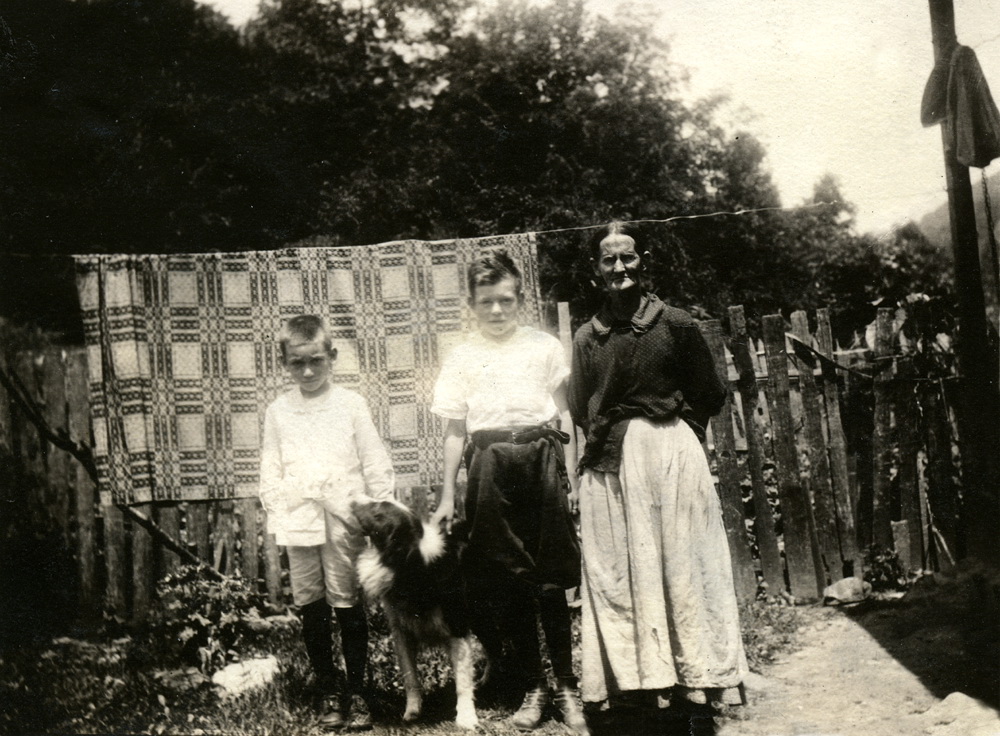
Neighbors in the Pine Mountain Valley with coverlet hanging behind mother, two children and dog. c. 1920s.
Pettit often traveled from Hindman in Knott County, where she had established her first school in the early years of the twentieth century. Even before the founding of Hindman, in 1901, Pettit was into her third summer season in the eastern Kentucky mountains at a location known as “Sassafrass.” She and her adventuresome colleagues had already journeyed to many of the remote valleys and hollows of nearby Harlan, Perry and Letcher counties where she frequently came into contact with mountain weavers. She soon began to search for coverlets to purchase and also found her interest in the craft gave her a sound introduction to many mountain families. While looking for homespun coverlets she soon discovered more than the coverlet. She discovered the weavers and their humble but rich skills, their ancient culture, and their stoic resourcefulness. Theirs was a life-style that she would soon come to cherish, partially adopt and commit to “raising up.”
In Harlan county she found the distance from the rapidly industrializing world she desired and she expanded on her Hindman experiences. She rapidly reached out to her many contacts and built a rustic home and a school dedicated to serving the people of the remote Pine Mountain valley and nearby hollows. She did not, however become a recluse.
When she came to Pine Mountain in 1913, and with the help of William Creech and the families living in the valley, Pettit established a school founded on the principles of the more urban settlement houses found in Chicago, New York, Boston and other locations. She recruited educators and workers from those early urban settlement schools and women’s colleges and sowed the seeds of a progressive educational program. What she created was a settlement school that adopted a unique response the urban settlement house ethos. While weaving in the urban settlements had often depended on teaching weaving that was modeled on practices found in the Arts and Craft’s Movement and in Scandinavian models, Pettit’s models were already established in the mountains of Kentucky and other areas of the Southern Appalachians. Weaving for Pettit and for the Pine Mountain community was an integral part of a response to the legacy of many families and the demands of a rural environment that was still in a pioneering and subsistence mode.
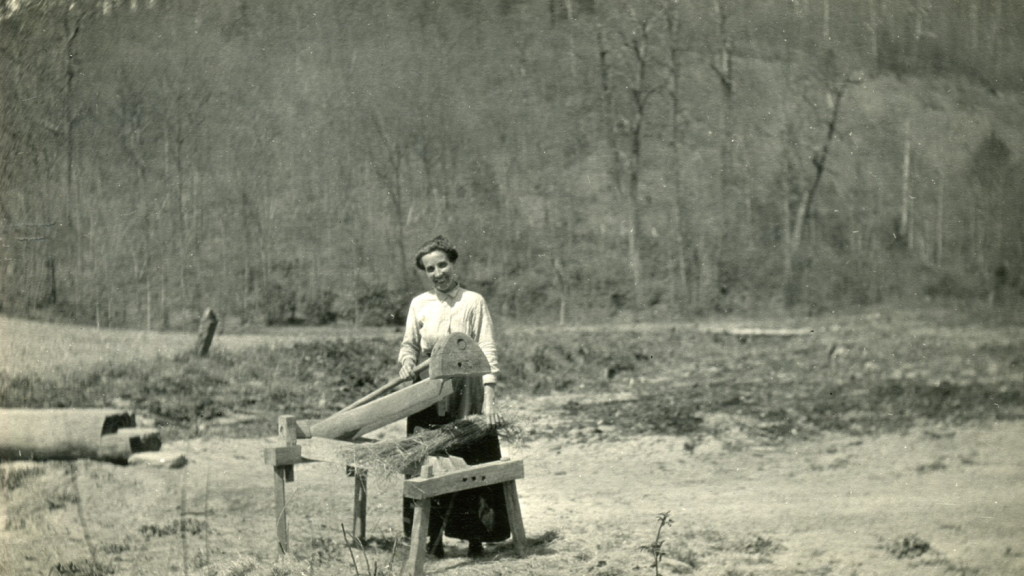
Beating flax using a wooden flax beater. Ethel de Long [?] X_099_workers_2527l_mod.jpg
Pettit made the Pine Mountain valley and the Settlement School her home and along with Ethel de Long, whom she had recruited away from Hindman Settlement School, she began to build the second of her schools in the region. Pine Mountain soon became one of the most unique and viable of the Southern Appalachian rural settlement schools. In that school the sound of the batten, weaving away, has rarely ceased it’s tempo.
At Pine Mountain Pettit and her staff did not live in isolation but challenged the people of the region to look beyond the walls of mountains surrounding their valley, to the flood of ideas, economies, and beliefs that would prepare the people of the region for the inevitable changes coming to the mountains. Following the turn of the century, industrialization was moving ever closer to the Pine Mountain Valley and Pettit recognized the need to develop a marketing strategy for the mountain crafts to bring money into the area. Weaving was part of her plan at “raising-up” the mountain people and she set about finding looms, building looms and establishing weaving as part of the school program.
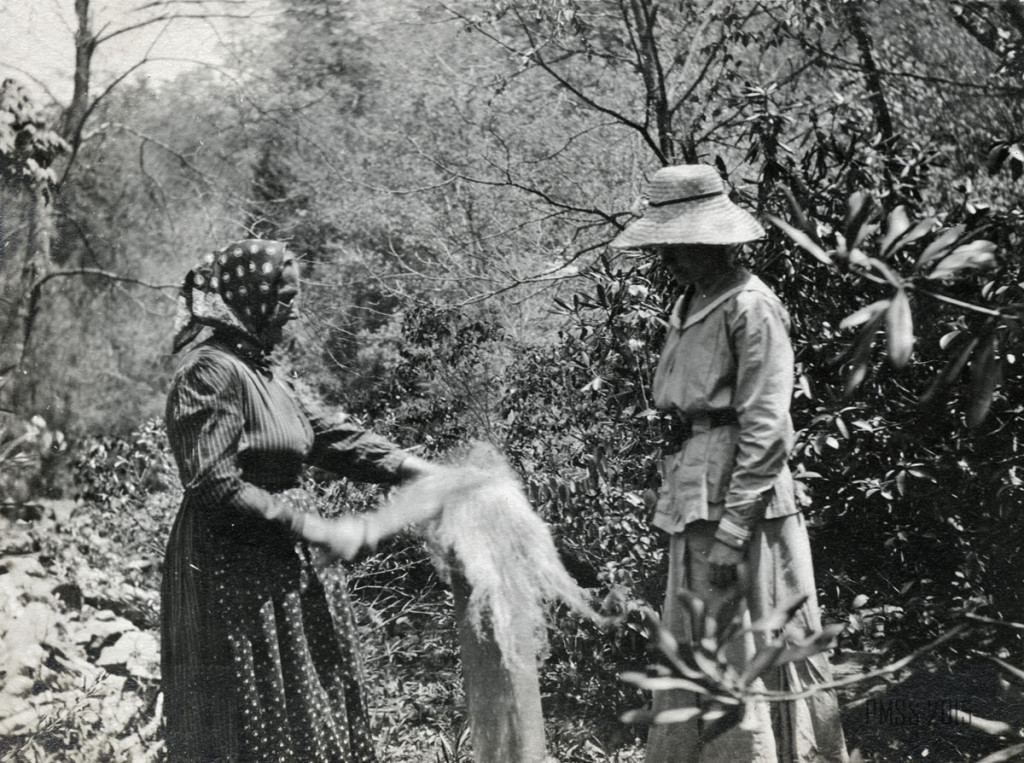
0050b P. Roettinger Album. “Swinging flax. Aunt Sal and Lizzie [Elisabeth Roettinger on right.]” [roe_017a.jpg]
The beautiful homespun coverlets discovered by Pettit on her mountain rambles became a visual passion for Pettit and for others who saw them. It is impossible not to have a deep appreciation for the skill and artistry of the craft of weaving and for the women and men who wove the exquisite and complicated patterns found in Pettit’s collection of coverlets. The mountain coverlet in all its complexity and subtle colors has a deep and extended history in the lives of mountain families with a weft that stretches back to Ireland and to Scotland, to France and to England. The coverlet is a visual testimony to the people’s deep intelligence, creativity, and manual skills, Often described as “asleep”, “apart”, “lazy”, “dull”, or worse, the early mountain weavers produced some of the most elegant and complex and extensive repertoires of coverlets. The Pine Mountain archive has long been the keeper of much of the history that documents the exquisite legacy of weaving in the Kentucky mountains.
From booklets that detail vegetable dying, such as the Katherine Pettit Dye Book, to implements that can convey the tactile activity of the weaver’s art, to correspondence related to the marketing of mountain craft by novel cooperatives such as Fireside Industries , to the intimate stories of times spent in homes where weaving was done, — the archives at the School are rich in weaving lore.
- The Katherine Pettit Book of Vegetable Dyes. pettit_dye_book_001.jpg
- The Katherine Pettit Book of Vegetable Dyes. pettit_dye_book_003.jpg
- The Katherine Pettit Book of Vegetable Dyes.pettit_dye_book_002.jpg
Shortly before Katherine Pettit died she left some of her weaving collections to Pine Mountain Settlement School but donated the bulk of her collection in May of 1936 to the Bradford Club of Lexington, Kentucky. Eventually, this large collection found its way into the holdings of Transylvania College by way of the historic home owned by the college, the Bodley-Bullock House, and under the care of the Junior League.
The Bullock’s were Pettit’s family. The home was obviously an active intellectual scene, filled with books and art, enjoyed by the patriarch, Waller O. Bullock, his wife, and children. Bullock, a physician and a sculptor, knew well the education of joining head and hand and heart, and no doubt passed that along to his children, one of whom was Clara, the mother of Katherine Pettit. The home, located adjacent to one of Lexington’s most impressive parks, Gratz Park, is surrounded by the homes of Lexington’s creative and intellectual elite, such as Henry Clay, the early entrepreneur William Gratz, John Wesley Hunt, the first millionaire west of the Alleghenies, and others.
Many of Pettit’s coverlets and textile fragments in both the Pine Mountain collection and the Bodley-Bullock collection have, in some cases, histories that go back some 200 years. Some have stories, and others have their provenance waiting to be discovered by researchers. But, all have a visual presence that cannot be denied and names that suggest ties with life in the family, region, and country as well as hints of ancient balladry and dance in the British Isles.
For example a beautiful peach and vanilla coverlet with a pattern called “Kentucky Winding Blades” in the Lexington collection, has the following attached note:
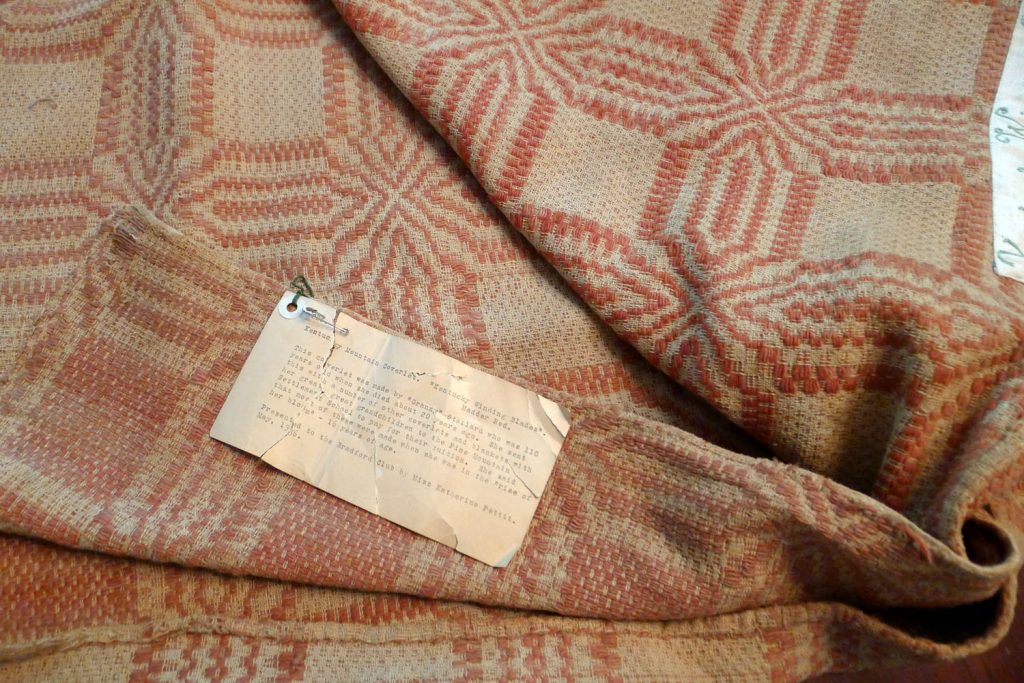
“This coverlet was made by Granny Stallard who was 110 years old when she died about 20 years ago [note:1936]. She sent this with a number of other coverlets and blankets with her great, great grandchildren to the Pine Mountain Settlement School to pay for their tuition. she said that most of these were made when she was in the “rise of her bloom” — sixteen years old.”
Another textile, un-named, a very worn and modified blanket/shawl has a badly damaged note that reads:
“This shawl was willed to … Uncle Enoch Combs, when he was a young man, not quite 20. [When he was] starting [for war] his sweetheart Nancy St … him and gave him this shawl [to ….] him. She told him to f… [when the] war was over. This he [did ?] … Uncle Enoch wore the shawl [until he was] an old man with long white [hair].”
Even this fragmented note tells of a very precious warp that is woven with the weft of memories; love, and loss and return and loss, again. So many of the weavings of Appalachia have these stories. They speak to what Eliza Calvert Hall calls the “Time Spirit” in her important 1912 book, The Book of Handwoven Coverlets. [1] The “time spirit” is found in that object that cannot be handled without recalling the life of the past. Many of the names of the coverlets speak to the past times. Stories, such as “Young Lady’s Perplexiuty,” [sic] “Lonley Heart,” “Youth and Beauty,” “Catch Me If You Can,” and “Lasting Beauty.” “… the rise of her bloom” is a mountain colloquial reference to the early adolescence of girls as it was often in early these years that girls began to learn to weave and to assemble their house-hold textiles for later marriage and their own homes. It can quickly be deduced that coverlets were often seen as the dowry of young girls. Certainly, they were the offerings that she carried into her marriage in her “Hope Chest”.
Eliza Calvert Hall has pointed out that the naming of coverlet patterns is a very imprecise practice. She says, ” … a design may have one name in North Carolina another in Kentucky, another in Tennessee, and still another in Virginia as if it were a criminal fleeing from justice.”
Enoch Combs [the same as mentioned earlier] and his wife Mary were a childless couple who lived at Sassafras, near Hindman. They were the hosts for a group of young women who came to the third and final summer camp in Knott county prior to the establishment of Hindman Settlement by Pettit and Stone. Katherine Pettit, of Lexington; Mary E. McCartney, of Louisville; May Stone, of Louisville; and Rae M. McNab, also of Louisville, traveled into what had become familiar, but still, very rugged mountains of eastern Kentucky. Their summer school at Sassafrass in 1901 was the last of a series of summer camps that were established to serve the literacy-poor hollows in Knott County. The success of these summer camps and the enthusiasm of Pettit and Stone led them to the foundation of a permanent school at Hindman in the following year.
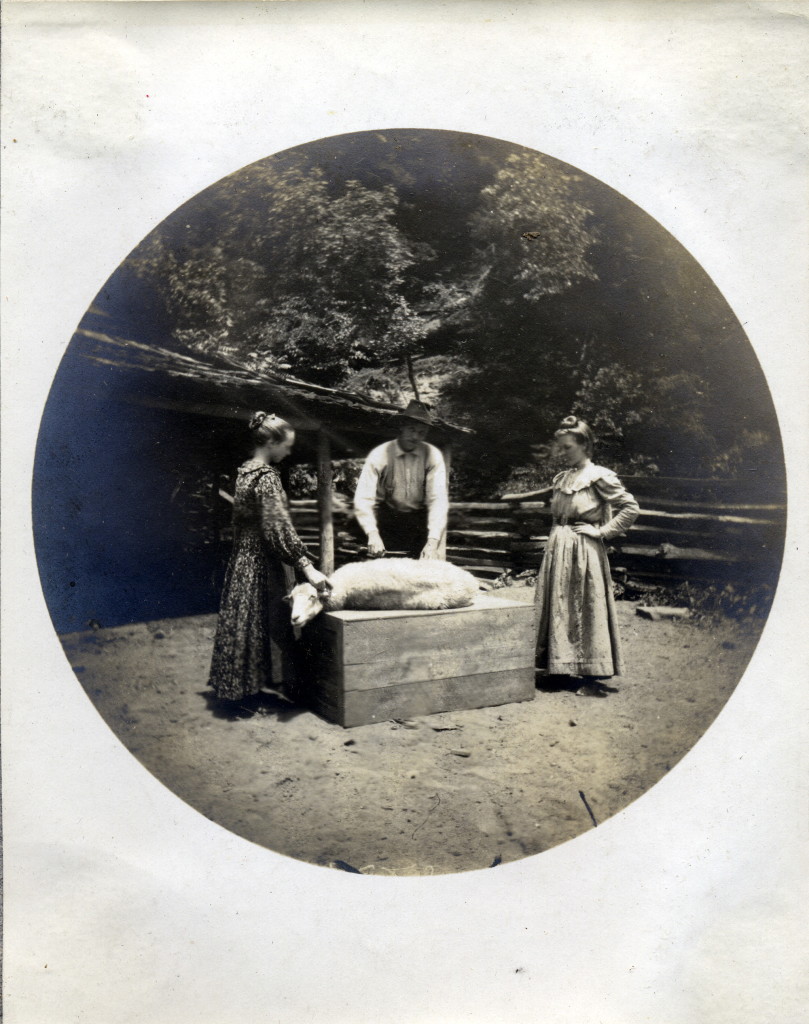
The life of the Combs family and their skills at weaving were captured in a small album of photographs belonging to Katherine Pettit which she titled “Sassafrass 1901.” In the small and fragile album, held in the Pine Mountain archive, members of the family and a young lady who was living with the Combs’ are shown shearing their sheep, washing the wool, drying the wool, picking and carding, dying the “hanks”, and finally spinning the wool to be placed on spindles. The images freeze this valuable pioneer process in time and allow the viewer to understand the many complex tasks associated with the manufacture of textile in the Appalachians.
FLAX
The processing of wool is just one of the complex tasks involved with Appalachian textiles. There is another even more arduous series of processes associated with the flax plant. When Katherine Pettit came to Pine Mountain she met “Aunt” Sally Creech. In Aunt Sal she had one of the finest weavers and spinners as an accomplice in her search for “kivers.” But, she also had a consummate teacher. Aunt Sal was the wife of William Creech, the farmer whose vision of a school caught the imagination of Pettit and whose land formed the basis of the physical site for the Pine Mountain Settlement School. Uncle William grew flax and harvested it to process linen thread. Katherine Pettit provided him with the seeds.
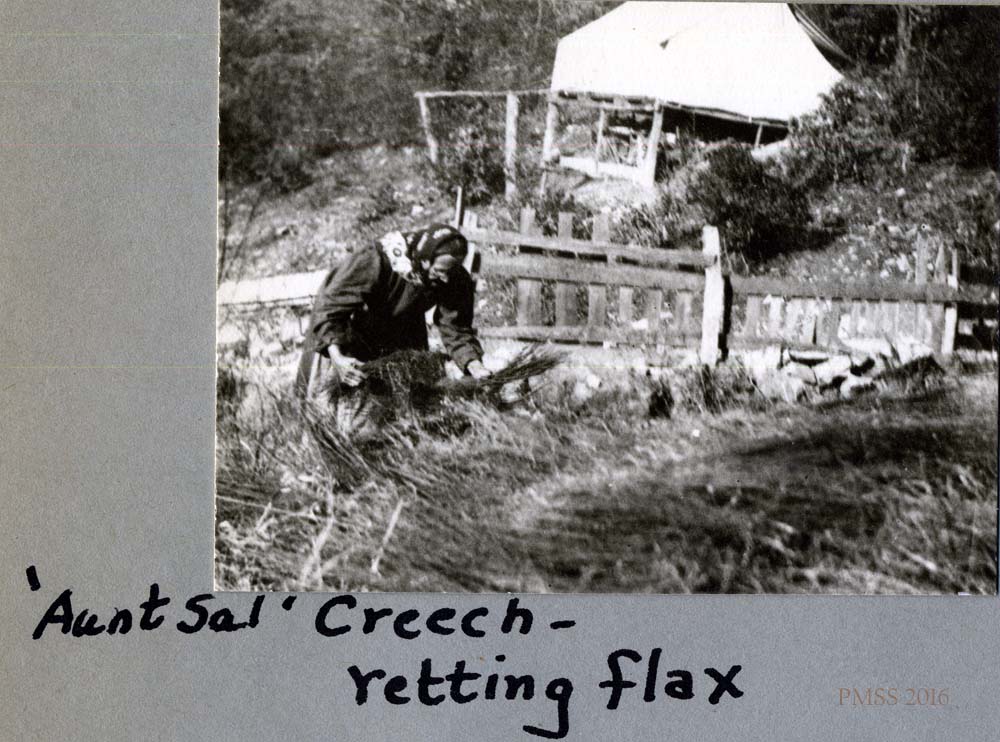
“‘Aunt Sal Creech – retting flax.” [nace_II_album_059.jpg]
At Pine Mountain, farmers who maintained subsistance farms in the small valley and hollows and on the steep slopes near the School sometimes found ways to extend their incomes by engaging in flax farming. Flax was one of the crops that could be turned to income. But, by the turn of the twentieth-century few of these resourceful farmers remained. Pine Mountain was fortunate that some of these flax farmers had passed down their knowledge in the family and there were families that were still growing and weaving with flax.

William Creech supervising the pulling of flax. [floral_III_020_mod.jpg]
When Pettit arrived in the valley she met families with names like Creech, Boggs, Turner, Couch, Combs, Coots, Day, Hall, and more, suggesting that the population was heavily indebted to England in its origins. A study of family names could shed light on possible English or Irish or Scotch origins of textile practice, but unlike tracing ballads or dances, or pageants, the trail for textile arts is not well developed. English families migrated to all areas of the British Isles but it is well-known that many Scots migrated to Ulster where they took up the practice of flax farming and production. However the practice arrived in the Appalachians, the production of linen thread, an enormously labor intensive and complex process was passed along to Uncle William and Aunt Sal. They knew the processes but the depth of their knowledge is difficult to determine. Just how their processes compared to European practice invites further study.
Certainly Uncle William saw an opportunity to pursue his farming interests and to combine this with the practice of weaving, an art his wife Sally knew well. Labor in the nearby school was available to him but he also had a sincere desire to improve the production of farmland, to educate, generally, and he, like Aunt Sal, was a consummate teacher. It is also clear that he shared these interests in flax farming with Katherine Pettit.
The raising of flax and its processing for the weaving of linen cloth is another long weaving story. It is evident, however, that farming and weaving and education all make good partners. Whether, wool, flax, or cotton, “Summer Weave”, “Snail’s Trail,” or “Virgil”, or “Longfellow”, the threads come together. It is true that the partnership of farming and weaving can be found repeated throughout the world, but the patterns derived from those partnerships are as diverse as the cultures that created them. Pine Mountain’s contributions to a weaving history are many and the contributions of Appalachia have their roots firmly planted in the long histories the earliest families brought to the region whether European, African, American Indian, or South American, or other cultures. There is strong evidence of cultural mixing in both practice and patterns and the research field waits for those who want a rich research project.
____________________________________
CRAFT WORKSHOPS AT PINE MOUNTAIN SETTLEMENT SCHOOL
For a schedule of events at the school , see:
http://www.pinemountainsettlementschool.com/events.php

